Rummy, an enthralling card game with a rich history, has captured the hearts and minds of players across the globe. The allure of rummy lies in its intricate strategies and the electrifying competition among participants. Consequently, rummy game development has become a growing industry, attracting both seasoned professionals and ambitious newcomers.
In the realm of digital gaming, rummy has found its niche. Transforming this classic pastime into a virtual experience is no small feat. It requires a delicate balance of honoring tradition while embracing cutting-edge technology. Game developers must navigate the labyrinth of player expectations, user interfaces, and gameplay mechanics. Oh, and let’s remember the ever-important monetization models!
In this article, let’s explore the rummy game development process and the involved cost. On this note, let’s look at some essential statistics before diving into the process.
Rummy Game Statistics
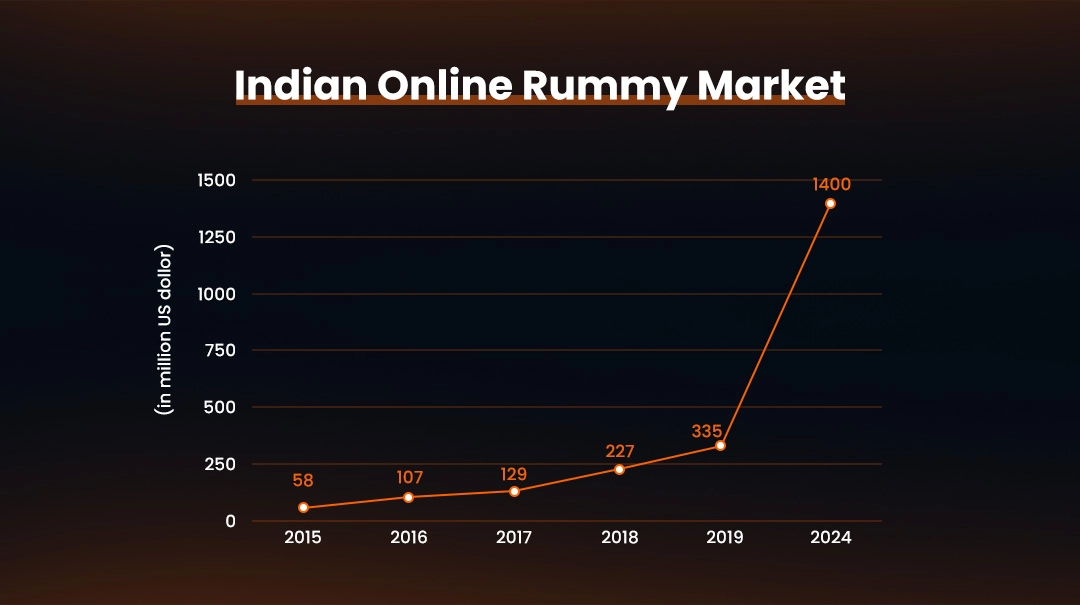
1. According to reports, the Indian online rummy market accounted for approximately $335 million in 2019, and it’s set the touch the mark of $1.4 billion by 2024 end.
2. Around 63% of the rummy players play the games to win real cash, whereas the rest 37% of the players open the game for fun.
3. According to Similarweb, there are more than 50 million active players that prefer to play online rummy games with their friends and other players.
So, before you hire rummy game developers looking at the statistics, let’s first explore some of the benefits of building a custom rummy game for your users.
Benefits of Developing a Rummy Game
Rummy, an age-old card game that has captivated the hearts and minds of millions, continues to be a popular choice among gaming enthusiasts. The digital era has opened up new avenues for rummy game development, catering to a wider audience while offering numerous benefits. Here, we delve into the advantages of rummy game development, exploring the intricacies of perplexity and burstiness.
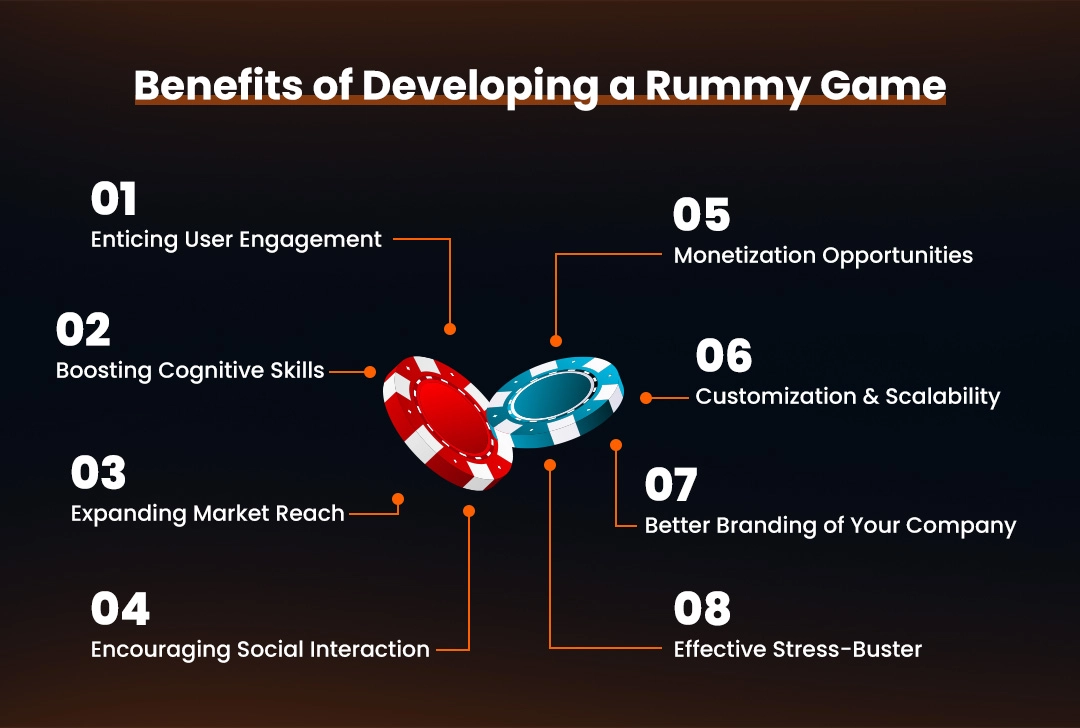
1. Enticing User Engagement
One cannot stress enough the importance of user engagement in today’s competitive gaming landscape. A well-developed rummy game, brimming with perplexity and burstiness, can pique players’ interest by offering a unique blend of challenges and rewards. The intricate nature of rummy, coupled with varying sentence lengths and complexities, keeps players on their toes, encouraging them to stay engaged and immersed in the game.
2. Boosting Cognitive Skills
It’s no secret that card games like rummy sharpen cognitive abilities. By incorporating engaging UX into the game’s experience, developers can further enhance players’ critical thinking, pattern recognition, and decision-making skills. As players navigate complex situations and diverse challenges, they exercise their mental faculties, honing their strategic thinking prowess.
3. Expanding Market Reach
With the advent of smartphones and ever-evolving technology, the market for digital rummy games has grown exponentially. Developing a rummy game creates an engaging and enthralling gaming experience and attracts a larger audience, increasing its market reach. Diverse demographics, from casual gamers to seasoned professionals, will be drawn to the challenge and excitement of such a game. By hiring a professional game development company, you can capture a larger market share.
4. Encouraging Social Interaction
Rummy, by nature, is a social game. In the digital realm, developing a rummy game that showcases perplexity and burstiness can foster even greater social interaction among players. Game developers can create a virtual community where players can forge new friendships, share strategies, and learn from one another by providing users with an engaging platform to interact, compete, and collaborate.
5. Monetization Opportunities
A well-crafted rummy game, replete with perplexity and burstiness, can open up various monetization avenues for developers. In-app purchases, advertisements, and premium features are just a few examples of revenue-generating opportunities. As the game’s popularity grows, so does its potential for profitability, making it an attractive investment for developers and investors.
6. Customization and Scalability
The flexibility of rummy game development allows for immense customization and scalability. Developers can tailor the game to cater to different player preferences and skill levels by integrating perplexity and burstiness into the design. Furthermore, as the gaming landscape evolves, developers can easily scale the game to accommodate new features, challenges, and technologies, ensuring its long-term success.
7. Better Branding of Your Company
Developing a rummy game that offers a seamless experience can significantly boost your company’s branding efforts. A captivating, skill-based game will attract a large audience and foster a positive association with your brand. Players who appreciate the game’s intricate design and engaging gameplay will be more likely to associate your company with quality, innovation, and entertainment, ultimately enhancing your brand image.
8. Effective Stress-Buster
In a world where stress is an all-too-common ailment, rummy games can serve as a much-needed respite for weary minds. By incorporating interactive features into the gameplay, developers can create a stimulating and engaging experience that allows players to escape their daily worries momentarily. The overall experience of such a game can captivate players’ attention, encouraging them to focus on strategizing and problem-solving while leaving their stress behind.

On this note, let’s look at the complete process of developing a rummy game. Thus, you will have a better understanding before you hire a game development company.
How to Develop a Rummy Game?
Rummy, a popular card game enjoyed by millions worldwide, offers an exciting challenge for developers who want to create their version. This section will dive into the essential steps and considerations for developing a rummy game that keeps players engaged and entertained.
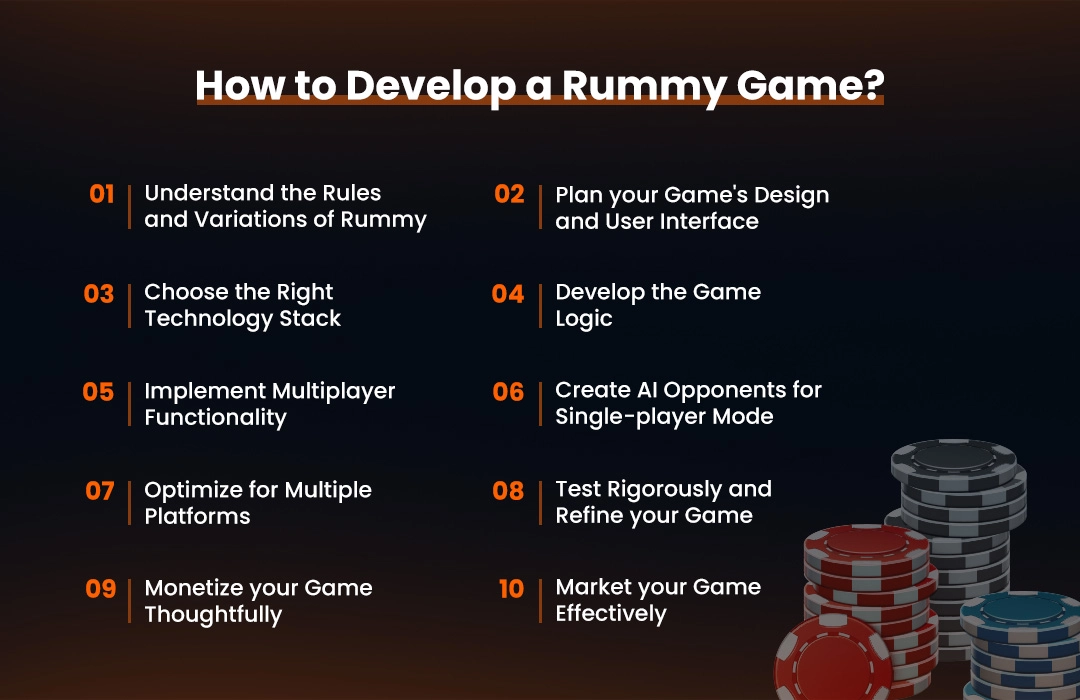
1. Understand the Rules and Variations of Rummy
First and foremost, get familiar with the basic rules of rummy and its various forms like Gin Rummy, Indian Rummy, and others. Each variation has unique features and strategies, so choose the one that appeals most to your target audience.
2. Plan your Game’s Design and User Interface
The visual elements of your gameplay hold a crucial role in attracting players. Spend time crafting a clean, user-friendly interface that’s easy to navigate while offering eye-catching graphics and animations. Remember, the goal is to create an immersive gaming experience.
3. Choose the Right Technology Stack
Selecting the appropriate tech stack for your rummy game is vital. Consider factors like scalability, performance, and ease of development. Some popular choices include Unity for game development, Node.js for the backend, and MongoDB for database management. Make sure you hire a professional company for game development services that can help you decide what tech stack and tools to use.
4. Develop the Game Logic
At the heart of any rummy game lies its logic, which governs how the cards are dealt, melded, and discarded. Be meticulous when coding the game mechanics, ensuring they align with the chosen rummy variation’s rules. Additionally, think about incorporating features like hints or tips for novice players.
5. Implement Multiplayer Functionality
Online rummy games thrive on social interaction. Therefore, integrating multiplayer capabilities is a must. Utilize technologies like WebSockets or real-time communication platforms to enable seamless interaction between players, allowing them to chat, collaborate, or compete.
6. Create AI Opponents for Single-player Mode
For those who prefer solo play, developing AI opponents with varying difficulty levels adds depth to the game. Implement machine learning algorithms to simulate human-like gameplay, providing an interesting challenge for players of all skill levels.
7. Optimize for Multiple Platforms
To reach a broader audience, ensure your rummy game is compatible with various devices and platforms, such as web browsers, smartphones, and tablets. Responsive design and cross-platform game development tools like Unity can help you achieve this goal.
8. Test Rigorously and Refine your Game
Before releasing your rummy game, conduct extensive testing to identify and fix bugs or glitches. Gather feedback from beta testers to fine-tune gameplay, improve the user interface, and address any other concerns.
9. Monetize your Game Thoughtfully
Consider incorporating in-app purchases, advertising, or a subscription model to generate revenue from your rummy game. Be mindful not to disrupt the gaming experience with intrusive ads or overly aggressive monetization strategies. So, when you opt for rummy game development services, consider multiple monetization strategies for your game.
10. Market your Game Effectively
Lastly, create a marketing plan to promote your rummy game and attract players. Utilize social media, online forums, and content marketing to generate buzz. Remember to monitor your game’s performance and user feedback, making updates and improvements as necessary.
Now, let’s explore how much time is required to develop a custom rummy game for your users so that you can plan things accordingly.
How Long Does It Take to Build a Rummy Game?
Building a rummy game is a fascinating endeavor, but the time it takes hinges on many factors. For instance, the scope and complexity of the game design play a pivotal role. A simple, single-player version without flashy graphics may be completed within a few months, while a multiplayer extravaganza with top-notch visuals and advanced features could take 6 months or even years.
It’s essential to consider the skills and resources at your disposal. A team of professional game developers and designers will undoubtedly expedite the process, bringing your rummy game to life in a shorter time frame.
On the other hand, if you’re a solo developer or working with a novice team, expect the journey to be more drawn-out. Completing a custom rummy game takes between 6 to 8 months. It’s essential to hire the best rummy game development team so that you can have the maximum ROI.
After exploring the development timeline aspects, explore the core factors that influence the overall cost of rummy game development.
Factors Affecting the Cost of Creating a Rummy Game
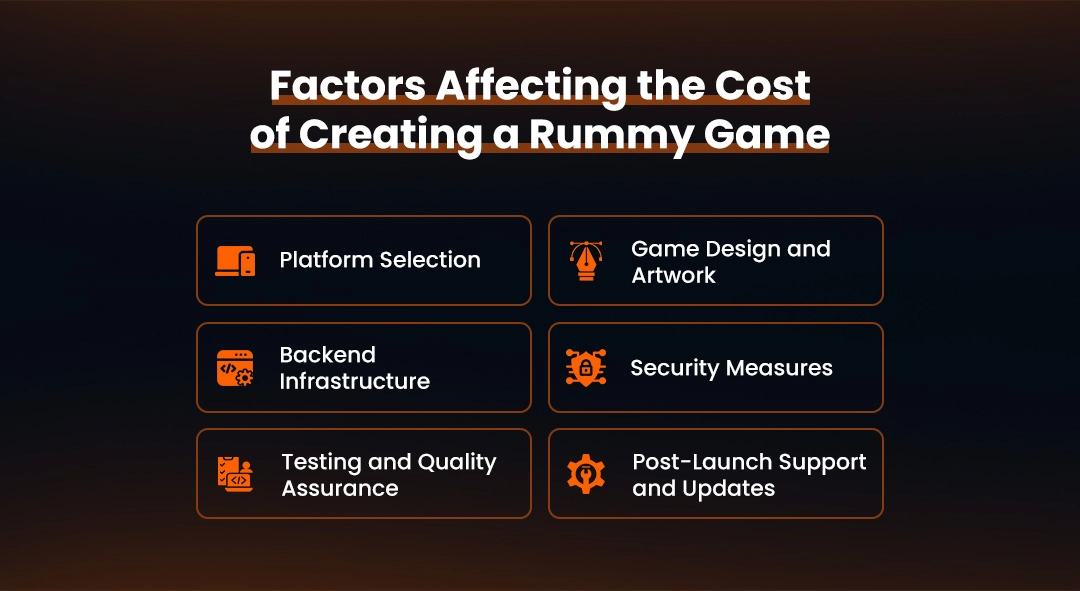
1. Platform Selection
One of the first decisions you must make when creating a rummy game is which platform(s) to target. Will your game be available on iOS, Android, or a web app? Each platform has unique development requirements, and choosing to develop for multiple platforms can significantly increase the overall cost.
Furthermore, the tools and technologies used for each platform may vary. For instance, while native iOS apps are developed using Swift or Objective-C, Android apps often rely on Java or Kotlin. Consequently, the choice of platform will also influence the cost of hiring game developers with the necessary expertise.
2. Game Design and Artwork
A visually appealing and well-designed rummy game is more likely to attract and keep players engaged. The cost of creating custom artwork, animations, and user interface (UI) elements can vary widely depending on the complexity and style you’re aiming for. Designing the game’s mechanics, rules, and overall structure will also factor into the cost equation.
Working with a skilled game designer is essential for bringing your vision to life, but it’s worth noting that their expertise often comes at a premium. Moreover, the time spent iterating and refining the game design will directly affect the overall development timeline and cost.
3. Backend Infrastructure
Rummy games require a robust backend infrastructure to handle player data, game logic, and real-time multiplayer interactions. Several factors, including the choice of server technology, database systems, and cloud services, can influence the cost of developing and maintaining this infrastructure.
Additionally, integrating third-party services like payment gateways, social media platforms, or analytics tools may require additional development effort and increase overall costs. It’s crucial to carefully assess your game’s backend requirements and select the most cost-effective and scalable solutions to support its long-term success.
4. Security Measures
With the ever-present threat of cyberattacks and data breaches, ensuring your rummy game’s security is paramount. Implementing robust security measures such as encryption, secure sockets layer (SSL) certificates, and regular vulnerability assessments can help protect your game and its players from potential threats.
However, these security measures often come at a cost in terms of initial implementation and ongoing maintenance. Balancing security needs with budget constraints can be a challenging task, but it’s essential to prioritize the safety of your game and its user data. It’s crucial to hire a professional rummy game development company like Auxano Global Services to gain an edge.
5. Testing and Quality Assurance
No game is perfect right out of the gate; thorough testing and quality assurance (QA) processes are necessary to iron out any bugs and ensure a smooth gameplay experience for your players. The cost of testing and QA can vary depending on the complexity of the game, the number of platforms it’s being developed for, and the desired level of polish.
Hiring dedicated QA testers or outsourcing testing to a specialized company can help ensure that your rummy game meets the highest quality standards. While this can add to the overall project cost, it’s a worthwhile investment to guarantee a positive user experience and maintain your game’s reputation.
6. Post-Launch Support and Updates
Finally, it’s crucial to consider the cost of providing ongoing support and updates for your rummy game after its launch. Regularly updating the game with new features, bug fixes, and performance improvements can help keep players engaged and ensure long-term success.
Additionally, offering customer support to address player concerns and resolve issues is vital for maintaining a positive reputation. Post-launch support and updates require time, effort, and resources, all contributing to the overall cost of creating a rummy game. Thus, while you hire dedicated game developers, also consider post-launch support services so that you can deliver a consistently superior experience to users.
Now, let’s jump on to the cost of developing a rummy game to understand how much you will need to spend to build a custom rummy game.
How Much Does It Cost To Develop a Rummy Game?
Developing a rummy game can be a lucrative endeavor, but it’s essential to consider its various aspects. Factors such as the game’s complexity, design, platform compatibility, and backend infrastructure all significantly determine the overall expenditure. Hiring freelance game developers or partnering with a professional game development company can also impact the final price tag.
A simple rummy game with essential features and minimalistic graphics could set you back anywhere from $15,000 to $50,000. On the other hand, if your vision involves an intricate, cross-platform game with stunning visuals, the cost will be up to $50,000 to $3,00,000 or more. Remember that ongoing maintenance, updates, and marketing efforts require a budget.
Thus, before you start looking for rummy game developers for hire, you must first define what you’re planning to build. In the next section, check out some practical tips to optimize the overall development cost for better ROI.
Bonus Point: Strategies for Reducing Rummy Game Development Cost
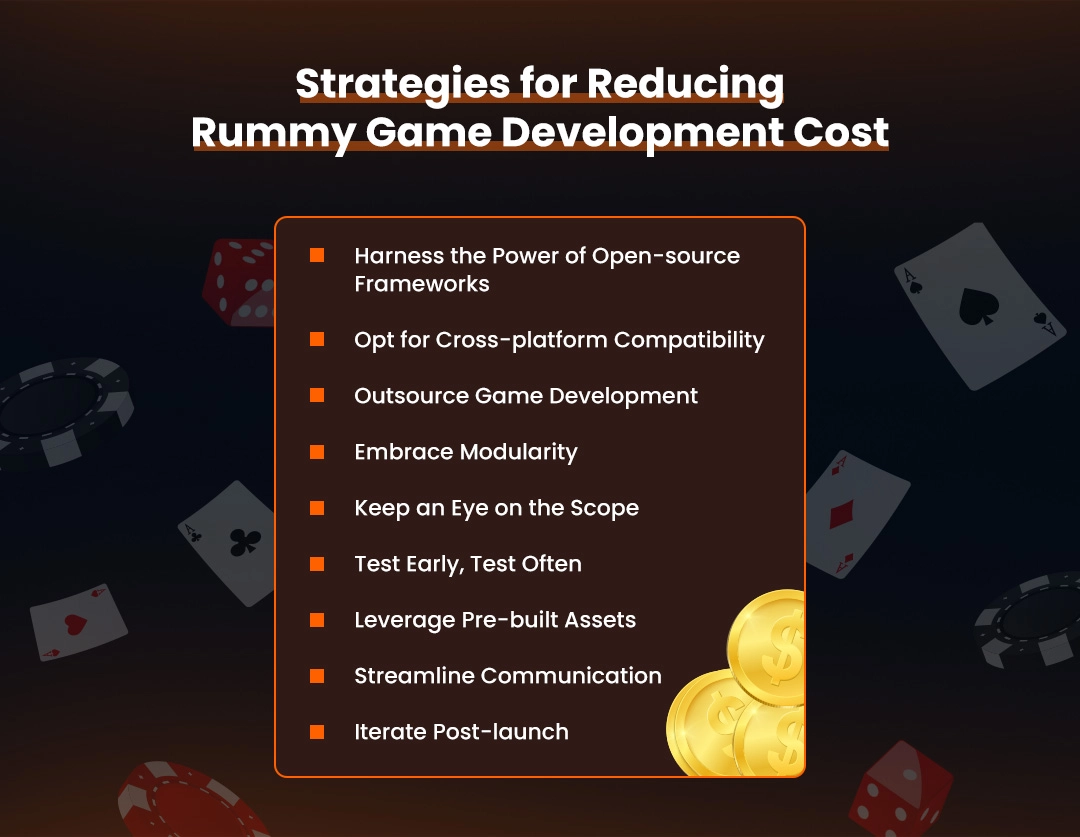
1. Harness the Power of Open-source Frameworks
Instead of starting from scratch, tap into the world of open-source platforms teeming with resources. You’ll discover cost-effective game engines, libraries, and tools, significantly reducing development time and expenses.
2. Opt for Cross-platform Compatibility
A single codebase that operates seamlessly across multiple platforms? It’s a developer’s dream! Using cross-platform development tools like Unity or Unreal Engine, you can efficiently create games for various devices without breaking the bank.
3. Outsource Game Development
Sometimes, it’s more economical to outsource game development from professionals with specialized expertise. However, practice caution when outsourcing; assess potential partners’ credibility and track record to avoid costly mistakes.
4. Embrace Modularity
Developing a modular game design allows you to reuse assets, mechanics, and code throughout development. This approach not only accelerates progress but also pares down expenses.
5. Keep an Eye on the Scope
Ambition is admirable, but it may lead to budget overruns in game development. Stay focused on your core objectives and resist adding unnecessary features that could inflate costs.
6. Test Early, Test Often
Identifying and resolving issues save a fortune in the long run. Adopting an iterative development process and continuous testing minimizes the risk of expensive, last-minute fixes. Go for professional mobile game development solutions that will also handle the QA part.
7. Leverage Pre-built Assets
Time is money, and creating custom assets can be labor-intensive. Save both by incorporating pre-built assets into your game from marketplaces like Unity Asset Store or Unreal Engine Marketplace.
8. Streamline Communication
Miscommunication among team members often results in wasted time and resources. Implement efficient communication channels and project management tools to keep everyone on the same page, reducing costly hiccups.
9. Iterate Post-launch
Resist the urge to pack every feature into the initial release. Instead, prioritize the essentials and plan to add additional features after launch. This approach allows for more accurate budgeting and keeps development costs in check.
By weaving these strategies together, you’ll have a high-quality rummy game without burning a hole in your pocket. You can thrive on higher market share and active users with the right game development solutions from a company like AGS.
Wrapping up!
In conclusion, the cost of developing a rummy game can vary greatly, depending on many factors. These include the game’s complexity, design, platform, and the developer’s expertise. Furthermore, one must also consider the expenses related to marketing, maintenance, and updates.
To ensure your rummy game’s success, it is crucial to invest in a skilled game development team and allocate resources wisely. By balancing quality and affordability, you can create an engaging and competitive rummy game that will attract players and stand the test of time. Remember, the ultimate goal is to provide a memorable gaming experience while keeping development costs within your budget.
People also like to read:-
How Much Does It Cost to Develop a Real Money Game?
50+ Profitable Business Ideas For Ultimate Success
Frequently Asked Questions
-
1. What’s crucial for a top-notch rummy game?
You’ll need a few key things! Make it easy to use, with solid rules and gameplay. Players should be able to play together online, so security and fairness matter too. And remember, it should work on different devices.
-
2. How do I pick the best tech for my rummy game?
Consider your game’s needs, like performance and compatibility. Think about what your team knows best, your budget, and the support you’ll get from other developers.
-
3. Do I need a web app for my rummy game?
Not a must, but it’s a great idea! With a web app, players can enjoy rummy anywhere, you’ll reach more people, and you can send them updates or reminders easily. Plus, it helps you stand out!
-
4. How can I make money from my rummy game?
There are a few ways! Offer in-app purchases, like special features or items. You could also have a subscription model, ads, or even host tournaments with entry fees.
-
5. How much does it cost to create a rummy game?
Several factors influence the overall development cost of a custom rummy game. On average, it will cost between $15,000 to $50,000 or more. If you want to know the exact price based on your requirements, then feel free to contact our professionals today.



![How Much Does It Cost to Develop a Puzzle Game? [2023]](https://www.auxanoglobalservices.com/agsresources/wp-content/uploads/2023/05/How-Much-Does-It-Cost-to-Develop-a-Puzzle-Game.jpg)
![Outsource Game Development [Complete Guide 2023]](https://www.auxanoglobalservices.com/agsresources/wp-content/uploads/2023/06/Outsource-Game-Development-Complete-Guide-2023.jpg)
